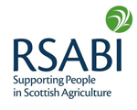We followed up with James Marshall at SRUC Easter Howgate who won the beef section in the AgriScot Silage Competition. James manages the unique farm which is a valuable site for research, demonstration, and teaching. The farm spans heather and blueberry moorland to arable cropping. There is a total of 400 suckler cows in the breeding herd split between 300 spring and 100 autumn calvers. They are made up of Aberdeen Angus cross, Limousin cross and pure Luings. Adding to this there are 1200 breeding hill ewes (Blackface and Cheviot) and 120 lowland ewes (Suffolk and Dorset).

James talked us through his silage production.
“Producing quality silage that is appropriate for our suckler herd is a key part of the farming system at Easter Howgate. I have been steadily improving most of the lowland ground since I have been here, and we are feeling the benefits. In general, we will aim to leave our swards down for 8-10 years before they are broken up with whole crop for one or two years. Pre and post whole crop the fields will be heavily dunged to increase fertility and improve organic matters. They will then be reseeded at the backend which I find reduces the weed burden in the field and they will be given a light graze to help with tillering and avoid any potential damage frost damage. The fields will then be raked and rolled in the Spring.
It is also important to get the grass mixture right and I will use late heading high sugar grasses. These grasses retain their quality throughout the season and fit in with our cutting date towards the end of May. Traditionally clover has been left out of the silage swards due to high fertiliser applications but with the rising price of nitrogen I have started to reintroduce clover into the mixtures. The soils are regularly soil tested and we have recently moved onto a GPS analysis. Low pH and nutrient levels will affect grass quality and any deficiencies will be rectified. Grass can use 2.5kg of nitrogen a day, 2.1kg of phosphate and 7.2kg of potash and this must be replaced. Due to lower emissions, we are no longer getting sulphur from the atmosphere, and it is also a key part of any fertiliser plan especially in later cuts. Getting soil fertility right is key to a healthy sward and will provide many benefits including longevity, clover establishment, soil structure and the ability to reduce other inputs.
The most influential factor in silage production is cutting date and earlier is generally better! While many areas will target early May our colder climate leads to slower grass growth, and we aim for a late May cut. It suits our system allowing the grass to reach its potential and use up any fertiliser and the contractors tend to be slightly quieter after the dairies have gone earlier. Cutting date is always a balance between yield and quality, but we are happy with the quality we are producing and are always around the 8 tonnes per acre fresh weight.
If the ground is dry, we set the spread width to maximum to increase the surface area for rapid wilting. If the ground is wet, we leave the grass in the swath, allowing the ground to dry out before tedding. With last year being so dry nothing got tedded and was wilted for 24 hours. Contractor Paul Nixon from the Borders uses his self-propelled forage harvester that ensures a uniform chop length and gets the grass into the pit fast. As the silage is coming in quickly, we use a silage compactor to improve compaction which for me is fundamental to good fermentation and should minimise losses. We use a silage additive Sil-All which for us works well as due to the research we carry out we can be slow getting through the pit and it helps reduce wastage. We use silage vapour barrier, black silage sheet and gravel bags. We use a block cutter to keep the job tidy and the face straight.”





